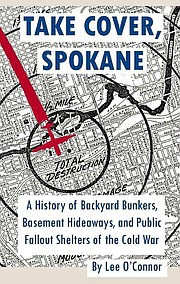Taking cover
MOSES LAKE — Go outside and take a look at the landscape around you. What do you see? Some houses most likely, maybe a natural water feature and hills off in the distance. Unknown to some eastern Washington residents is that hidden across the landscape there is a rich history waiting to be shared with the world at large. That is where authors like Lee O'Connor step in to tell the secret stories that often times go untold.
The Seattle author stopped by the Moses Lake Museum & Art Center on Saturday for a signing of his book “Take Cover, Spokane.” The book details Spokane’s backyard bunkers, basement hideaways and public fallout shelters, as residents of the city prepared for the worst during the Cold War.
“I became interested in the subject after finding an old map on eBay back in 2003 and just started investigating it more over the years,” O’Connor explained.
O’Connor didn’t initially plan to write “Take Cover, Spokane. He originally had his sights set on a book detailing the construction, management and decommissioning of missile silos in the Columbia Basin. O’Connor started researching the missile silo book and went to graduate school at Washington State University. His advisors suggested he choose a subject he could write about in a shorter amount of time because the missile silo research was so broad and vast.
His advisors believed he would have an easier time writing about Spokane’s fallout shelters and could gather information for the missile silo book along the way. He said he expects the book to be completed sometime in the next couple of years.
“I’ve been working on it since before 2003. I first visited the missile bases in about 1993 when I was in high school and in the back of my mind I always wanted to learn about them and study the history behind them,” he explained. “I have most of my research done for the construction and the operation of the missile silos. And now I want to learn about what has happened to them after they were decommissioned in 1965.”
“They are abandoned now around Odessa, Warden and Royal City.”
O’Connor encouraged anyone and everyone who might have information on the missile silos to contact him at takecover@outlook.com. O’Connor’s work plays into the focus of a new exhibit that is set to open at the MAC, which details how Americans were taught to survive worst-case scenarios of the Atomic Age. “Alert Today, Alive Tomorrow” debuts at the museum on Friday and is scheduled to be on display through Nov. 10. The event is free and open to the public.
Richard Byrd can be reached via email city@columbiabasinherald.com





